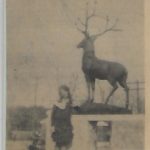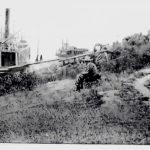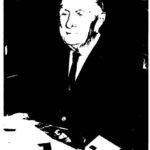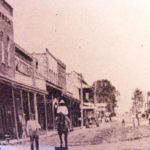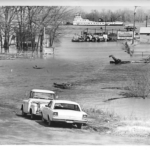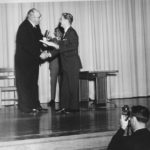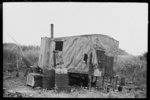Throwback pictures from Facebook – 2019
For more content like this and what is posted on Facebook, join the Pemiscot County Historical Society for only $10 a year. The four quarterlies contain many more pictures like these, along with articles about the history of places in the county. Come by Caruthersville Public Library to complete your registration.
The interior of a local theater – any guesses about which one you think that it belongs to? Rodgers, Stadium or Gem??
Colonial Federal began on West Third Street in Caruthersville and then built a nice new building on Ward Avenue. Here it is decked out for the holidays. (This later became Bank of Missouri and they moved into their brand-new facility on Highway 84 in early 2018.)
The Caruthersville Church of Christ had outgrown its building at 11th and Carleton in the early 1960s and constructed a much larger facility in the southern part of the city, which was experiencing rapid growth at the time.(The Caruthersville Church of God now occupies their former church on Carleton.) Here is a picture of the building, now known as a different church, Jesus Name Tabernacle, which experienced heavy damage in the tornado of 2006 and had extensive renovation.
The Caruthersville Fire Station headquarters before 1957 was located on West Fourth Street. Can anyone identify the three firemen in the picture?
This 1927 photo of Mildred Hudgings Greer, who lived in Hayti at the time, shows her standing beside the elk at Little Prairie Cemetery in Caruthersville. Mrs. Greer was a lovely 14-year-old girl at the time, and the large, bronze elk atop the LaForge monuments attracted people from all over to see it.
A gentleman moves bales of cotton at the storage warehouse in Caruthersville in the earlier part of the 20th century.
The Collins home, located at East Third and Walker, now owned by Mrs. Collins’ grandson, Bob Hughes and his wife, Janet, is shown here soon after its construction in 1895.
An early Caruthersville citizen lazes on the riverbank and watches the steamboats arriving in the city.
Recent Wall of Distinction honoree, Lee Dorroh’s father, Charles prepares to take a ride in a buggy with the West Sisters in 1903. The home at East 8th and Bushey is shown in the background.
 This photograph comes from way back when there was no levee and these local businesses were right next to the Mississippi River during times of high water.
This photograph comes from way back when there was no levee and these local businesses were right next to the Mississippi River during times of high water.
Pictured is the Grand Opening of the Ashley’s Outlet Store in the former Graber Building in the 300 block of Ward Avenue in the early 1970s. (This lot is now vacant.) Mayor B. F. “Hot” Rogers is pictured in the center of the photo surrounded by Ashley’s financial officers, regional manager and local store manager.
The fitting room at Brown Shoe Company is shown here before the closing of the Caruthersville plant in 1994. It had been a vital employer in the city for 50 years.The shoe industry was a mainstay in rural economies at the turn of the century. As many as 26,000 workers depended on Brown for employment by the early 1970s, before the factories began the move to Mexico, China, India and in several parts of Asia.
Pemiscot County has known five courthouses, three in Gayoso, which was the county seat from 1851 until 1899, and two in Caruthersville, the present county seat. The county purchased 50 acres in Gayoso in 1854 and built a small frame building on the public square. County officials used this courthouse until 1873, when it was moved and converted for another purpose.
The second courthouse was built in 1873 with $750 obtained from the state legislature. This building burned Dec. 2, 1882.
Again the county obtained an appropriation from the state, this time of $4,000. Maj. George W. Carleton superintended construction of a two-story, square, frame building with cupola, which continued in use until the county voted to move the seat to Caruthersville in 1899, after repeated flood damage at Gayoso as shown in photo. The courthouse was adapted to other use. (Pemiscot County Courthouse, Gayoso, ca. 1883-1899 – Courtesy: State Historical Society of Missouri, gift of Mrs. Josamyn S. Garrett)
For the new county seat in Caruthersville, residents donated the site and Charles B. Faris superintended construction on the square of a two-story, white, frame courthouse with hip roof, which the county used until 1925
Figure 2
Pemiscot County Courthouse, Caruthersville, 1899-1924. (Courtesy: Ophelia Wade. From: Riparian Lands of theMississippi River)
In 1924, as preparation began for building the fifth and present courthouse, the county offered the old courthouse for sale. When no acceptable bids came, officials decided to move the courthouse to the northwest corner of the square, where it continued in use until dismantled and sold in 1925.
Caruthersville planned simultaneous construction of a school and courthouse to save money and assure close supervision of both projects by the architect, Henry H. Hohenschild. The building contract for the courthouse was given in June 1924 to McCarthy Construction Co. for about $114,000, less than the original estimate because prices had declined.
Cornerstone ceremonies for the stone-trimmed, brick courthouse took place on Sept. 30, 1924, and the building was completed in the fall of 1925 (Figure 3). Scott County, just two counties north of Pemiscot, had built a similar design by Hohenschild in 1911. Both courthouses are fine examples of one of Missouri’s most prolific architects.
Figure 3
Pemiscot County Courthouse, 1924-. Architect: Henry H. Hohenschild (From: Caruthersville Centennial, 1857-1957)
Renovation of the courthouse was undertaken in July 1974; Henry Creighton, architect, planned the interior and Bien Construction, Dexter, were general contractors. Work was completed in June 1975.
(Credit to the University of Missouri Extension website for this historical information.)
Sterling Price Reynolds was Pemiscot County’s oldest citizen, who died at the age of 106. Mr. Reynolds was the engineer who drained “Swampeast” Missouri. He was a long-time engineer for the St. Francis Levee District, who was charged with the construction and maintenance of the Mississippi levee, which protects the rich fertile soil of Pemiscot County.
(Pemiscot County, Missouri – A Pictorial History 1994 – Compiled by Ralph Clayton)
Mr. Reynolds was born in Callaway County, Mo., November 9, 1861 and died in January of 1968. He attended the Callaway County schools and Westminister College at Fulton before entering Missouri University, where he was graduated from the School of Engineering in 1883. He was the oldest living graduate of the university at the time of his death.
He came to Caruthersville in 1897 and became chief engineer of the St. Francis Levee District in 1900, holding the position until he became ill after his 100th Birthday. He was also president of the Little River Drainage District.
A highlight of his career was his 100th birthday, when the city celebrated in his honor and dedicated Reynolds Park on the bank of the Mississippi.
These photos shows Mr. Reynolds in his later years, as well as the memorial dedicated to him at Reynolds Park, and the MO Conservation Department’s sign at the riverfront near the former flagpole there.
One of the taxi stands that were a fixture in the city during the 1930s,1940s and 1950s. Also, phone numbers were very easy to remember in those days – only three numbers.
The Dixie Air Dome was a part of Caruthersville’s entertainment. Built in 1910, it was located about where the parking lot behind First State Bank is now. (At his time, 2nd Street was called Charles Street, 3rd Street was called George Street, 4th Street was James Street) Another Air Dome (Theater) was Skip’s Air Dome, which seated 650 people and was owned by J. B. Skipper. It was located across from the current Post Office on Carleton. Finally there was the Garden Air Dome around 1909, located across the street from the Caruthersville Business College.
Remember Baskin Drug Store in the 1100 block Of Ward, where Tiger Hut and the Money Ball were located more recently? This photo from an older advertisement shows a picture of the soda fountain, which remained until the late 1960s.
Here are some pictures of downtown Caruthersville and downtown Steele from the early 1900s. The first is from the archives of the Pemiscot County Historical Society. The other two are compliments of Clay Richardson and show flooding from the Pemiscot Bayou during this same time period.
The old Caruthersville Depot on West 3rd Street in Caruthersville. This was once a major fixture of Frisco Park, where City Hall is now located. In later years, it was used as the Pemiscot County museum but it fell into disrepair and was torn down to make room for today’s Veteran’s Park.
This is a picture taken inside one of the men’s stores which occupied several Ward Avenue locations in Caruthersville’s heyday.
Remember Powell’s Ferry Landing? This is a picture of the Landing during major river flooding in the 1960s or 1970s.
Todd Nettleton recently sent us these pages from LIFE Magazine when President Truman visited the Pemiscot County Fair. For those who haven’t seen this article before, it is quite interesting to see our town depicted with national coverage.
Ferguson’s First Addition was one of the city’s first housing districts on the west side of Ward Avenue. Some of the residences in this section were Dr. C. F. Wood, W. A. Kennedy, Joe B. Darnall, George W. Quillen, and B. T. Davenport.
Mr. Redman Dunham, longtime educator in Caruthersville, received a Certificate of Merit from Caruthersville Public Schools on May 24, 1966, “in appreciation for the fine service rendered through the years to the youth of your community. This tribute is extended as a great honor for the influence and effect which you have exerted upon the lives of the many boys and girls who have come under your guidance.” Signed by School Board president Noel C. Dean, Board secretary John R. Fowlkes, and Superintendent W. V. Hill.
Ward Avenue in the early part of the 1900s The Bank of Caruthersville, now where Focus Bank resides, is shown on the right of the picture.
Several citizens in the late ’70s receive certificates for their work in the city. How many do you recognize?
The interior of one of Caruthersville’s earliest post offices, pictured in 1912 and located on West Third Street where The Sportster was formerly located.
Hometown hero John England, who has the memorial plane at England Park, which is named after him. (Submitted from Wikipedia)
John Brooke England (15 January 1923 – 17 November 1954) was a World War II fighter ace in the American 357th Fighter Group and a career fighter pilot in the United States Air Force.
He was the son of Bidker H. and Pearl J. England of Caruthersville, Missouri. After graduating from Caruthersville High School on 16 May 1940, he worked as a bookkeeper and later he marketed various agricultural commodities. Growing up on the banks of the Mississippi River, his favorite hobby was fishing.
Following the United States entry into World War II, England enlisted in the United States Army on 1 April 1942. He was accepted into aviation cadet training and was sent to Yuma, Arizona, where his flight instructor was future U.S. Senator and presidential candidate Barry Goldwater. He completed his flying training on 9 March 1943. He was then commissioned as a second lieutenant and received his pilot’s wings on 10 March 1943.[1]
After this training, he was assigned to the 362d Fighter Squadron of the 357th Fighter Group, which was then flying the P-39 Airacobra. The 357th moved to Santa Rosa, California and then moved for additional training to Oroville, California in August 1943. After additional moves and training in other states, the personnel of the 357th boarded the RMS Queen Elizabeth and sailed from New York City on 23 November 1943.
The unit was assigned to RAF Leiston and after transitioning to the P-51 Mustang, they flew their first combat mission on 11 February 1944. England was promoted to first lieutenant on 26 October 1943 and by the time he was promoted to captain on 28 April 1944 he already had 6.5 aerial credits. After his first victory on 8 March 1944, he attained the status of “ace” in only forty-eight days.
He took command of the 362d Fighter Squadron on 25 August 1944 and continued as the squadron commander until 8 April 1945. He was promoted to major on 4 December 1944 and continued to fly combat sorties achieving his last aerial victory on 14 January 1945 for a total of 17.5 enemy aircraft destroyed in flight.
After the war, Major England stayed in the Air Force. By 1949 he was promoted to lieutenant colonel and was given command of the Air Force’s cadet training school at Nellis AFB, Nevada.
On 5 June 1949, he married Marilyn Ruth Boswell and they had three children. During this time he formed a flight demonstration team called “The Red Devils”, flying World War II-era P-51 Mustangs painted an all-over red. The team was short-lived, because the Mustangs and England were needed for service in Korea.
England served briefly in the Korean War flying six combat missions and on 20 February 1951 he was promoted to lieutenant colonel. In October 1953, he was assigned to Alexandria Air Force Base in Alexandria, Louisiana as commander of the 389th Fighter-Bomber Squadron where he flew the F-86 Sabre. The squadron deployed to Toul-Rosières Air Base, France in the fall of 1954. From Toul, England flew a mission for gunnery practice near Tripoli, Libya. He was then returning to Toul from Marseille, France, on 17 November 1954. Due to bad weather and low visibility, he made several attempts to land and on his final approach his engine flamed out due to lack of fuel. As he attempted to land without power he was killed while trying to avoid a barracks building. For this selfless act, Alexandria AFB was renamed England Air Force Base.
He was the leading ace of World War II from Missouri and England City Park in Caruthersville, Missouri has a memorial in his honor. Part of the inscription on the plaque reads “This memorial of Colonel England is dedicated to and represents the highest tradition of American fighting men lost in wars fought for the preservation of our freedoms.”
England was buried at Arlington National Cemetery on 30 November 1954.
The Class of 2019 had 67 students to graduate, and in 1957 there were 68 graduates. How about a yearbook page from 1957, Caruthersville’s centennial year, describing their graduation?
The Caruthersville Centennial Parade in June of 1957. This view is from just south of 5th and Ward Avenue.
With wrestling returning locally in the upcoming days to benefit the Recreation Center, this old wrestling poster is interesting. It was being held at the East Third Street Arena (possibly the Armory?) and reserved seats were available at The City Pig, where Lux & Luv is now located on East 5th Street.
In the book “Caruthersville, MO 150 Years”, resident Steve Dale discussed “Tin Town” a small area on the east side of town north of the railroad tracks near the Caruthersville riverfront: “I remember it well. It was a community of what we today would call “homeless” people. The shanties they lived in were built out of discarded crate wood and whatever they could find in the city dump, shingled with flattened-out tin cans. There were several families there, for the most part, hard-working day laborers doing the best that they could. They worked every day at whatever day labor jobs they could find, and sent their kids to school.”
Houses were often damaged by high river water and had to be repaired by materials found at the nearby city dump. Because the living conditions in Tin Town were so dangerous to health, the city council began to enforce ordinances regarding “Outhouses” and other violations, forcing the small community’s disappearance by the late 1950s. Also, the Environmental Protection Agency (EPA) developed new minimum standards for garbage disposal and burning that led to the end of the city dump at the end of East 7th Street behind the levee, where Tin Town was located (and ironically, in the vicinity of where Lady Luck Casino now stands).
Courtesy of Tommy Clayton, today’s blast from the past features an original program from the December 1976 opening of the Caruthersville bridge.
Since it is National Library Week, we thought it would be appropriate to throw it WAY back to the building of the 1940 Library here in Caruthersville. Construction began the year before, in 1939 after the city voted approval of the new building in mid-1938. It was constructed through a WPA program that also brought our town the Armory. The middle picture is an outside view of the library taken for the grand opening advertisement. The final picture is an interior view of the library when it was brand new.
As late as the mid-1930’s, nine out of ten rural homes were without electric service. The farmer milked his cows by the dim light of a kerosene lantern. His wife worked tirelessly keeping wood in the stove and used washboards and buckets to clean clothes. The unavailability of electricity kept factories and businesses from locating in rural areas. For many years power companies ignored rural areas around the nation.
The first official action of the federal government leading the way to present rural electrification program came with the passage of the Tennessee Valley Authority Act, also known as the (TVA) Act, in May 1933. This gave the TVA board the ability to build lines to serve farms and towns that otherwise were not supplied with electricity.
The idea of providing federal assistance to rural America for electrification grew rapidly when President Roosevelt took office in 1933. On May 11, 1933, Roosevelt signed Executive Order No. 7037, establishing the Rural Electrification Administration (REA). It was not until a year later that the Rural Electrification Act was passed and the lending program that became the REA got it’s start.
Within four years following the close of the war, the number of rural electrical systems in operation doubled, the number of customers tripled, and the miles of line grew more than five- fold. By 1953, more than 90 percent of American farms had electricity thanks to the REA programs.
Today, nearly 100% of the nations farms have electrical service. Most of the rural farms have received electric because of the product of your locally owned rural Cooperative. The Cooperatives got their start by borrowing funds from the REA to build lines and provide service as a not for profit basis. Today, REA is known as Rural Utilities Service (RUS). RUS is part of the U.S. Department of Agriculture.
Pemiscot-Dunklin Electric Cooperative was started from the REA program, organized in September of 1937. The Cooperative was very much needed and well received in the area. The Cooperative experienced rapid growth and quickly became the largest Electrical Cooperative in the state of Missouri. By July 1950, about 90% of the Pemiscot-Dunklin area was electrified. The Cooperative had 14 trucks equipped with 2-way radios to improve service to their members. In the late 1950’s the number of members began to decline as members left the rural areas and started migrating to the cities for employment. This gave the Cooperative new challenges to face as memberships declined by as much as one third over the next several years. Despite this decline the Cooperative’s mission has always stayed the same: to provide reliable service to the members. As time goes by, things change but Pemiscot-Dunklin Electric Cooperative still takes tremendous pride in providing members with reliable service and involvement and promotion of rural Missouri.
Seven-month-old Plessie Ellitt IV distracts his mother, Laveta Lockridge, during Sunday morning services at Mt. Carmel Baptist Church in Caruthersville in 1987.
The image was part of the photo exhibit called Documenting the Black Experience in Small Town Missouri. The images were selected from the archive of the Missouri Photo Workshop (MPW), founded in 1949 by Clifton Edom, a professor at the University of Missouri School of Journalism in Columbia. Over the past 60 years, more than 2,000 photographers have documented 43 Missouri communities at MPW.
“The images touch the chords of universal human experience,” says David Rees, co-director of MPW. “Some pictures will resonate with each person in a very personal way.”
Other scenes captured in Caruthersville include the visual stories of teacher Elna Hill, who had a long teaching career in the Bootheel community. J.J. Bullington, the school superintendent, not only had been Hill’s student but also had taught with her when she returned to Caruthersville to begin her own career in 1982.
The railroad depot on West 3rd Street near the Post Office in Caruthersville in the early 1900s.

Children in Steele, MO during the 1940’s take a look at the movie posters outside the theater. (Steele actually had two movie theaters: The Palace Theater, which was a short-lived theater opening in 1931. The theater seated 225 and closed in 1935. It has since been demolished; and The Steele Theater was opened in the 1920’s when it had 300 seats. It was remodeled in 1944 and the seating capacity increased to 450. It was still open in 1955.)
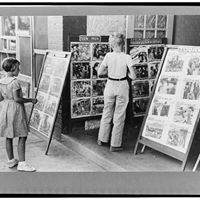
Here is a picture from way back, looking toward the river on Ward Avenue. On the right is the current Focus Bank, then called the Bank of Caruthersville. See what other familiar buildings and businesses you can identify.

This team began as the West Plains Badgers, based in West Plains, Missouri in 1936. They then became the Batesville, Arkansas Pilots. They were an affiliate of the St. Louis Cardinals in the Northeast Arkansas League. The team moved to Caruthersville, Missouri on June 11, 1936 and became the Caruthersville Pilots.

Caruthersville Public Library was established in February of 1922 by the Caruthersville Woman’s Club, so this month commemorates our 97th birthday. It was first housed in the belfry of the Presbyterian Church, then was moved to the house pictured here. (This house still is standing, but was moved from its original location shown here. It is now located on the south side of West 10th, near Carleton Avenue.) In 1940, the building on Ward was constructed as part of a WPA Project during World War II, and then in 2002, Caruthersville Public Library moved into our new spacious building where it is now.
This is a picture of Nanson’s Dry Goods Store, which changed hands in 1913. It was located on the site of the Old Supply House Stand.
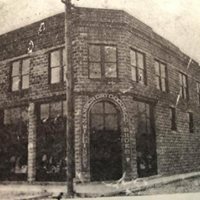
One of the three movie theaters in Caruthersville in the 1940s and 1950s, the Stadium was located at the corner of 11th and Ward. The other theaters were the Rodgers Theater on Third Street and the Gem Theater at 12th and Ward.
The Chaffin Motor Hotel, where President Harry Truman slept when he visited our city in the late 40s and early 50s. It was destroyed in a huge fatal fire in November of 1979.

The Independant Oil Company was a busy service station in the city for many years.

Brown Shoe Company stood on West 13th Street where the library is now located.

This picture was taken from the 15th street side of the Brown Shoe Company.

A picture of the original Riverview Museum which was just across the seawall on Ward.

J.S. Walhl Bottling Company was located at 4th & Carleton, on the land where Pemiscot Office Supply is doing business today.

A Christmas parade photo, featuring the CHS Band, from the late 1970s.





